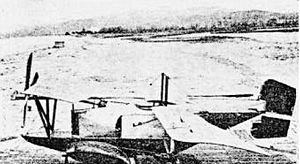Manufacturer Breguet Aviation | Designer Louis Charles Breguet | |
 | ||
The Breguet Aerhydroplane was a large experimental flying boat developed in France in 1912. It proved to be underpowered and never flew.
Huge for its day, it was a parasol-wing monoplane of canard configuration (described in some sources as a tandem wing design on account of the wide span of the foreplane relative to the mainplane) with a single tractor propeller turned by a chain drive from an engine located within the hull. The hull was designed for Breguet by Alphonse Tellier and featured wide sponsons. The empennage was the cruciform tail common to early Breguet designs. Christened La Marseillaise, it was displayed at the Salon de l'Aéronautique in 1912 and demonstrated at Monaco by Breguet in 1913 along with his more conventional H-U2 and H-U3 seaplanes. Here, it proved itself capable of maneuvering on water, but not of actually taking off, its 97 kW (130 hp) engine being incapable of making its 2,000 kg (4,410 lb) weight airborne. All development was abandoned at this point.
Specifications
General characteristics
Performance
